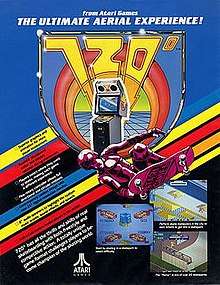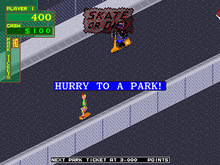720°
720° is a skateboarding video game released in arcades by Atari Games in 1986.[1] in which the player controls a skateboarder skating around a middle-class neighborhood. By doing jumps and tricks, the player can eventually acquire enough points to compete at a skate park. The game's name comes from the "ultimate" trick, turning a full 720° (two complete circles) in the air after jumping off a ramp.
| 720° | |
|---|---|
 Arcade promotional flyer | |
| Developer(s) | Atari Games |
| Publisher(s) | Atari Games |
| Designer(s) | John Salwitz Dave Ralston |
| Composer(s) | Arcade Hal Canon Earl Vickers Brad Fuller NES Neil Brennan |
| Platform(s) | Arcade, Amstrad CPC, Commodore 64, NES, ZX Spectrum, Game Boy Color |
| Release | December 1986 |
| Genre(s) | Sports |
| Mode(s) | Up to 2 players, alternating turns |
| Cabinet | Upright |
| Arcade system | Atari System 2 |
| CPU | T-11 @ 10 MHz |
| Sound | YM2151 @ 3.58 MHz 2 × POKEY @ 1.79 MHz TMS5220 @ 625 kHz |
| Display | Horizontal, Raster, medium resolution (Used: 512 × 384) |
Plot
From official materials:
- "It's just you, your trusty skateboard, and a hundred bucks as you skate, jump, slide, spin and move through four levels of difficulty, picking up loose cash, earning money through events, and finally, earning a ticket to one of the big skate parks! If you're lucky, you'll get to buy some rad equipment to make you the coolest skateboarder alive."
Gameplay
The game begins with the player controlling a skateboarder skating around a middle-class neighborhood using common objects as ramps for jumps.
The player begins with a number of "tickets," each of which granting admission to one of four skate parks, or "events," in Skate City, the "hub" between the parks. When a park is entered, one ticket is expended. The player gains additional tickets from earning points. Whenever the player isn't in an event, a bar counts down the time remaining until the arrival of a swarm of killer bees accompanied by the caption of "SKATE OR DIE!". Once the bees arrive the player still has a small amount of time with which to get to a park, but the longer the player delays this the faster the bees become, until they are unavoidable. Getting caught by the bees ends the game, though on default settings the player may elect to continue his game by inserting more money. Reaching a park with a ticket gives the player the chance to earn points, medals and money with which to upgrade his equipment, and resets the timer.
The player is constantly racing to perform stunts, both in the events and in the park itself, in order to earn the points needed to acquire tickets. Thus, the player's score is directly tied to the amount of time he has to play the game. In order to win, the player must complete a total of sixteen events through four hubs, a difficult task.
Structure

The game consists of four levels each consisting of four events:
- Ramp: the player climbs around a half-pipe structure, trying to gain more and more height and performing tricks in the air to earn the most possible points. This ends when the timer runs out.
- Downhill: a long course consisting of slopes and banks must be navigated to reach a finish line. The quicker the player reaches the finish, the more points are earned.
- Slalom: an obstacle course in which the player is required to pass between pairs of yellow flags scattered across the course. Each gate passed grants a little extra time, and scoring depends on time remaining upon crossing the finish line.
- Jump: the player jumps from a series of ramps, attempting to hit a bull's-eye target off the screen. There are cryptic marks on the ramp before the jump that provide clues as to the location of the target. This ends when the timer runs out or the player crosses the finish line, whichever comes first.
Scattered through the levels are several "map" icons placed on the ground which when activated show a map with the roads, parks, shops, and the player's location marked on it. Also scattered about the level are hazards and obstacles, jumping over hazards earns points.
The player earns points and money for high scores in each event, and doing well at the events earns the cash needed to buy equipment that improves player performance, and a chance at a bronze, silver, or gold medal. Completing all four events in all four classes completes the game.
Equipment
There are four types of skating equipment to be purchased at different shops. The prices for each are the same, beginning at $25. Upon each return to Skate City after visiting a park, the price increases by $25, to a maximum of $250.
- Shoes: Allow higher jumps and faster acceleration.
- Board: Allows higher top speed.
- Pads: Give quicker recovery from wiping out.
- Helmet: Makes the player more aggressive, according to the console description; which translates to making the player spin faster.
Arcade cabinet
The speakers for the game are mounted atop the cabinet in a structure resembling a boombox, in line with the game's skate-rat theme. The display is larger than that for a typical arcade game and very high resolution (similar to that used for Paperboy). The joystick is rigidly mounted to a disc at a steep angle and moves in a circular fashion, instead of in compass directions like standard joysticks. The game also contains two buttons, one for "kicking" (which refers not to actual "kicking", but refers to pushing the skate board with a foot for speed) and the other for jumping.
Ports
The game was ported to the Commodore 64 (twice) in 1987, the Amstrad CPC and ZX Spectrum in 1988, the Nintendo Entertainment System (NES) in 1989, and the Game Boy Color in 1999. There is also an unreleased port for the Atari Lynx. Tiertex Design Studios ported the Amstrad CPC, ZX Spectrum and the first Commodore 64 version, U.S. Gold published them. and Sinclair User described it as "US Gold's finest hour".
Reception
| Reception | ||||||||||||||||||||
|---|---|---|---|---|---|---|---|---|---|---|---|---|---|---|---|---|---|---|---|---|
| ||||||||||||||||||||
Legacy
Emulated versions of the game are included in Midway Arcade Treasures, released in 2003 and 2004, Midway Arcade Origins, released in 2012, and Lego Dimensions, released in 2015.[11]
References
- "720°". The International Arcade Museum. Retrieved 5 Oct 2013.
- GDC (2019-05-01), Classic Game Postmortem: Paperboy, retrieved 2019-05-10
- "Crash Magazine Issue 47". Newsfield. Retrieved 2018-05-08.
- "CVG Magazine Issue 075". EMAP. Retrieved 2018-05-08.
- "Classic Reviews: 720°". Game Informer. 10 (91): 162. November 2000.
- "Sinclair User Magazine Issue 068". EMAP. Retrieved 2018-05-08.
- "Your Sinclair Magazine Issue 25". Dennis Publishing. Retrieved 2018-05-08.
- "The Games Machine Issue 02". Newsfield. Retrieved 2018-05-08.
- "MicroHobby Magazine Issue 164". Hobby Press. Retrieved 2018-05-08.
- "ACE Magazine Issue 04". Future Publishing. Retrieved 2012-02-11.
- Midway Arcade Origins Review - IGN
External links
- 720° at the Killer List of Videogames
- 720° at the Arcade History database
- Contemporary reviews at Solvalou.com
- 720° at SpectrumComputing.co.uk